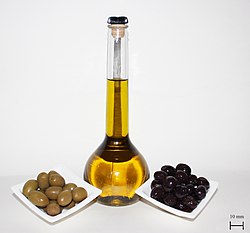
Back زيت الزيتون Arabic زيت زيتون ARZ Aceite d'oliva AST Zeytun yağı Azerbaijani Зәйтүн майы Bashkir Аліўкавы алей Byelorussian Аліўкавы алей BE-X-OLD Зехтин Bulgarian Maslinovo ulje BS Oli d'oliva Catalan
 Extra virgin olive oil presented with green and black preserved table olives | |
| Fat composition | |
|---|---|
| Saturated fats | |
| Total saturated | Palmitic acid: 13.0% Stearic acid: 1.5% |
| Unsaturated fats | |
| Total unsaturated | > 85% |
| Monounsaturated | Oleic acid: 70.0% Palmitoleic acid: 0.3–3.5% |
| Polyunsaturated | Linoleic acid: 15.0% α-Linolenic acid: 0.5% |
| Properties | |
| Food energy per 100 g (3.5 oz) | 3,700 kJ (880 kcal) |
| Melting point | −6.0 °C (21.2 °F) |
| Boiling point | 299 °C (570 °F) |
| Smoke point | 190–215 °C (374–419 °F) (extra virgin)[1] 215 °C (419 °F) (virgin)[2] 210 °C (410 °F) (refined) |
| Solidity at 20 °C (68 °F) | Liquid |
| Specific gravity at 20 °C (68 °F) | 0.911[3] |
| Viscosity at 20 °C (68 °F) | 84 cP |
| Refractive index | 1.4677–1.4705 (virgin and refined) 1.4680–1.4707 (pomace) |
| Iodine value | 75–94 (virgin and refined) 75–92 (pomace) |
| Acid value | maximum: 6.6%[inconsistent](refined and pomace) 0.8% (extra virgin) |
| Saponification value | 184–196 (virgin and refined) 182–193 (pomace) |
| Peroxide value | 20 (virgin) 10 (refined and pomace) |
Olive oil is a liquid fat obtained by pressing whole olives, the fruit of Olea europaea, a traditional tree crop of the Mediterranean Basin, and extracting the oil.
It is commonly used in cooking for frying foods or as a salad dressing. It can also be found in some cosmetics, pharmaceuticals, soaps, and fuels for traditional oil lamps. It also has additional uses in some religions. The olive is one of three core food plants in Mediterranean cuisine, together with wheat and grapes. Olive trees have been grown around the Mediterranean since the 8th millennium BC.
Spain is the world's largest producer, manufacturing almost half of the world's olive oil. Other large producers are Italy, Greece, Tunisia, Turkey and Morocco.
The composition of olive oil varies with the cultivar, altitude, time of harvest, and extraction process. It consists mainly of oleic acid (up to 83%), with smaller amounts of other fatty acids including linoleic acid (up to 21%) and palmitic acid (up to 20%). Extra virgin olive oil is required to have no more than 0.8% free acidity and is considered to have favorable flavor characteristics.
- ^ Gray, Sarah (2015). "Cooking with extra virgin olive oil". ACNEM Journal. 34 (2): 8–12. S2CID 132454216.
- ^ De Alzaa, F.; Guillaume, C.; Ravetti, L. (June 2018). "Evaluation of Chemical and Physical Changes in Different Commercial Oils during Heating". Acta Scientific Nutritional Health. 2 (6): 2–11. Archived from the original on May 6, 2021. Retrieved May 6, 2021.
- ^ "United States Department of Agriculture: "Grading Manual for Olive Oil and Olive-Pomace Oil"". Archived from the original on October 31, 2014. Retrieved June 25, 2013.
© MMXXIII Rich X Search. We shall prevail. All rights reserved. Rich X Search